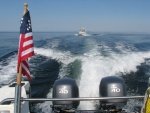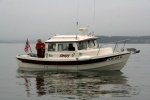CDory23":2v7kli0s said:
Hi all,
I"m considering purchasing a Lowrance Fuel flow sensor:
http://northernmarineelectronics.com/lo ... 11517-001/
This would be for my HDS 7 Gen 2 touch. This isn't a necessary addition but I'm curious as to my fuel flow at certain RPM's and I think it would help me optimize my fuel usage and be handy on longer trips such as Catalina island. I also just think its a cool gadget in general. I have twin outboards and I was considering just buying one and putting it in line between my fuel selector switch and fuel filter/water seperator. This obviously will only give me total fuel usage and not separate engine data. Does anybody have any experience with these and/or any reasons why I should consider purchasing one for each engine?
Thanks
I have one on my dual tank single engine installation. The manual says the sensor should be after the Racor filter. The sensor needs to be installed in a certain orientation.
Out of the box it is calibrated pretty close. You can refine it if you want. At low engine speeds there may not be enough flow for the detector to sense. If you spend a lot of time there your readings might be off. At low engine speeds on FI engines you might see the FF go from zero to some value and then zero again as the low pressure pump on the engine cycles.
I use the LMF-200 display. With a GPS input you can get remaining range in addition to FF, MPG, Fuel Used.
If the unit is on and you get a low bus voltage (e.g. during engine start) you can screw up the saved info and the values reset. I found it is better to have the unit off during starts to prevent this from happening. Same thing happens to the battery monitor.
Since the sender is a bus device and "smart", sometimes it does not initialize correctly. You have to reboot it by cycling power or rescanning the NMEA network although this may be an issue with the display unit and not the sensor). While you can hook the network up to the ignition switch, it is handy to have a power switch for the sender or the network for this purpose and the low voltage issue mentioned above.
I was most interested in the remaining range function. I found that after using the FF indicator for a while that the numbers are pretty consistent (at least on my boat). So the indicator is a bit redundant now. I know the FF at various RPMs and can do the math in my head. We have a comfortable cruising speed for our boat that we travel at a majority of the time (~18 mph) if conditions allow.
The remaining range is calculated dynamically. In rougher water the value will change as the boat speeds up and slows down in the waves and the engine revs change. So you may have to filter the numbers in your head to get an idea of the actual remaining range.
The sensor is mechanical (an impeller in a tube). It can fail or get jammed up. I've had one sensor fail pretty early on (second day I used it).
It would be nice if there was a portable system you could rent or borrow that was self contained and easy to hook up. One could use it for a couple of days to get the numbers and then return it/send it to the next guy. You could reuse it every couple of years to revalidate your cruising numbers or after an engine refit.
All in all it is interesting information. However, I still look at the sight gauges for the tanks regularly to check the remaining fuel quantity.


